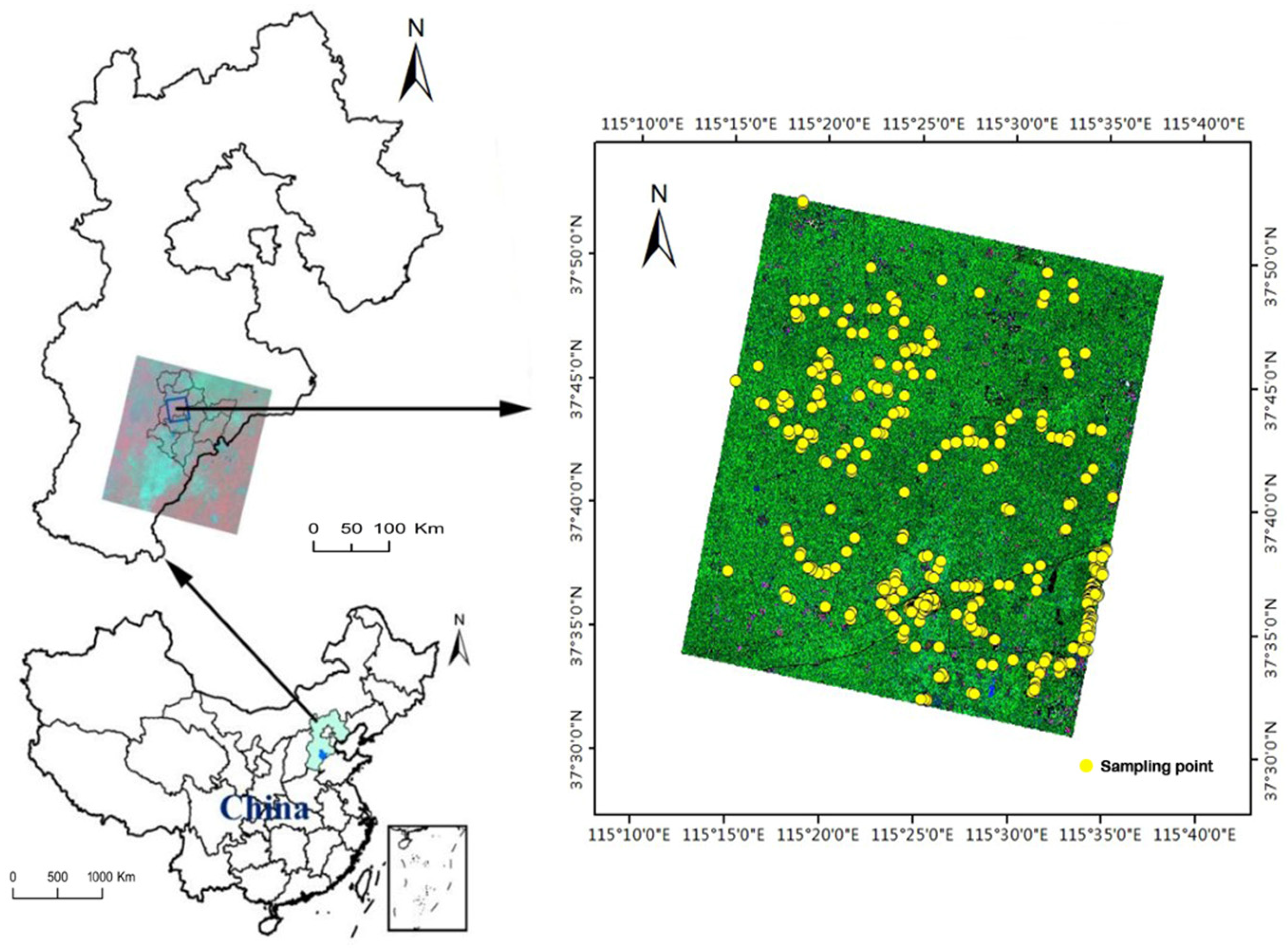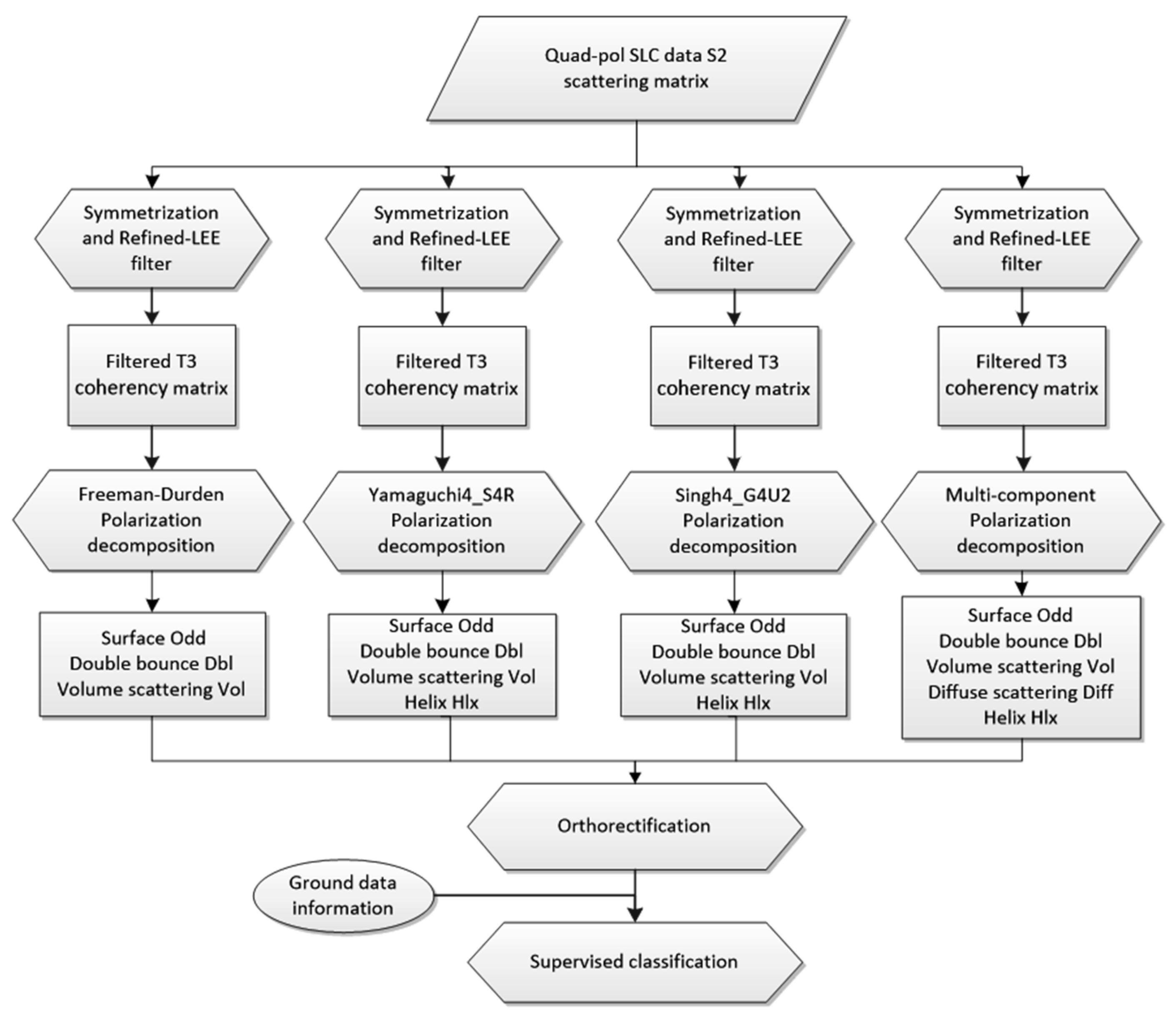Assessment of GF3 Full-Polarimetric SAR Data for Dryland Crop Classification with Different Polarimetric Decomposition Methods
Abstract
:1. Introduction
2. Materials and Methods
2.1. Test Site and Image Data
2.2. Sampling
2.3. Principles and Methods
2.3.1. Freeman–Durden Decomposition Method
2.3.2. Sato4 Decomposition Method
2.3.3. Singh4 Decomposition Method
2.3.4. Multi-Component Decomposition Method
2.3.5. Supervised Classification Method
2.3.6. GF3 Polarization SAR Data Processing Method
3. Results
3.1. RGB Image Composition
3.2. Image Classification
3.3. Accuracy Assessment
4. Discussion
5. Conclusions and Future Research
- (1)
- Compared with the typical polarization decomposition method, the accuracy of the classification results using the new decomposition method was highly improved,
- (2)
- The accuracy was effective for dryland crop identification using the GF3 polarimetric data, and it demonstrated the great promising potential of GF3 SAR data for dryland crop monitoring applications.
Author Contributions
Funding
Institutional Review Board Statement
Informed Consent Statement
Data Availability Statement
Acknowledgments
Conflicts of Interest
References
- Johnson, D.M.; Mueller, R. Pre- and within-season crop type classification trained with archival land cover information. Remote Sens. Environ. 2021, 264, 112576. [Google Scholar] [CrossRef]
- Shao, Y.; Fan, X.; Liu, H.; Xiao, J.; Ross, S.; Brisco, B.; Brown, R.; Staples, G. Rice monitoring and production estimation using multitemporal RADARSAT. Remote Sens. Environ. 2001, 76, 310–325. [Google Scholar] [CrossRef]
- Chakraborty, M.; Manjunath, K.R.; Panigrahy, S.; Kundu, N.; Parihar, J.S. Rice crop parameter retrieval using multi-temporal, multi-incidence angle Radarsat SAR data. ISPRS J. Photogramm. Remote Sens. 2005, 59, 310–322. [Google Scholar] [CrossRef]
- Choudhury, I.; Chakraborty, M. SAR signature investigation of rice crop using RADARSAT data. Int. J. Remote Sens. 2006, 27, 519–534. [Google Scholar] [CrossRef]
- Chakraborty, M.; Panigrahy, S.; Sharma, S.A. Discrimination of rice crop grown under different cultural practices using temporal ERS-1 synthetic aperture radar data. ISPRS J. Photogramm. Remote Sens. 1997, 52, 183–191. [Google Scholar] [CrossRef]
- Baghdadi, N.; Boyer, N.; Todoroff, P.; El Hajj, M.; Bégué, A. Potential of SAR sensors TerraSAR-X, ASAR/ENVISAT and PALSAR/ALOS for monitoring sugarcane crops on Reunion Island. Remote Sens. Environ. 2009, 113, 1724–1738. [Google Scholar] [CrossRef]
- Jia, K.; Li, Q.; Tian, Y.; Wu, B.; Zhang, F.; Meng, J. Crop classification using multi-configuration SAR data in the North China Plain. Int. J. Remote Sens. 2012, 33, 170–183. [Google Scholar] [CrossRef]
- Shang, J.; McNairn, H.; Champagne, C.; Jiao, X. Application of Multi-Frequency Synthetic Aperture Radar (SAR) in Crop Classification. In Advances in Geoscience and Remote Sensing; IntechOpen: London, UK, 2009. [Google Scholar]
- Zhu, Z.; Woodcock, C.E.; Rogan, J.; Kellndorfer, J. Assessment of spectral, polarimetric, temporal, and spatial dimensions for urban and peri-urban land cover classification using Landsat and SAR data. Remote Sens. Environ. 2012, 117, 72–82. [Google Scholar] [CrossRef]
- Dong, J.; Xiao, X.; Chen, B.; Torbick, N.; Jin, C.; Zhang, G.; Biradar, C. Mapping deciduous rubber plantations through integration of PALSAR and multi-temporal Landsat imagery. Remote Sens. Environ. 2013, 134, 392–402. [Google Scholar] [CrossRef]
- McNairn, H.; Champagne, C.; Shang, J.; Holmstrom, D.; Reichert, G. Integration of optical and Synthetic Aperture Radar (SAR) imagery for delivering operational annual crop inventories. ISPRS J. Photogramm. Remote Sens. 2009, 64, 434–449. [Google Scholar] [CrossRef]
- Soria-Ruiz, J.; Fernandez-Ordoñez, Y.; Woodhouse, I.H. Land-cover classification using radar and optical images: A case study in Central Mexico. Int. J. Remote Sens. 2010, 31, 3291–3305. [Google Scholar] [CrossRef]
- Phan, H.; Le Toan, T.; Bouvet, A.; Nguyen, L.D.; Pham Duy, T.; Zribi, M. Mapping of Rice Varieties and Sowing Date Using X-Band SAR Data. Sensors 2018, 18, 316. [Google Scholar] [CrossRef] [PubMed]
- Dey, S.; Mandal, D.; Robertson, L.D.; Banerjee, B.; Kumar, V.; McNairn, H.; Bhattacharya, A.; Rao, Y.S. In-season crop classification using elements of the Kennaugh matrix derived from polarimetric RADARSAT-2 SAR data. Int. J. Appl. Earth Obs. Geoinf. 2020, 88, 102059. [Google Scholar] [CrossRef]
- Silva-Perez, C.; Marino, A.; Lopez-Sanchez, J.M.; Cameron, I. Multitemporal Polarimetric SAR Change Detection for Crop Monitoring and Crop Type Classification. IEEE J. Sel. Top. Appl. Earth Obs. Remote Sens. 2021, 14, 12361–12374. [Google Scholar] [CrossRef]
- Alberga, V.; Satalino, G.; Staykova, D.K. Comparison of polarimetric SAR observables in terms of classification performance. Int. J. Remote Sens. 2008, 29, 4129–4150. [Google Scholar] [CrossRef]
- Shah Hosseini, R.; Entezari, I.; Homayouni, S.; Motagh, M.; Mansouri, B. Classification of polarimetric SAR images using Support Vector Machines. Can. J. Remote Sens. 2011, 37, 220–233. [Google Scholar] [CrossRef]
- Zhang, Y.; Wang, C.; Wu, J.; Qi, J.; Salas, W.A. Mapping paddy rice with multitemporal ALOS/PALSAR imagery in southeast China. Int. J. Remote Sens. 2009, 30, 6301–6315. [Google Scholar] [CrossRef]
- Cloude, S.R.; Pottier, E. A review of target decomposition theorems in radar polarimetry. IEEE Trans. Geosci. Remote Sens. 1996, 34, 498–518. [Google Scholar] [CrossRef]
- Strzelczyk, J.; Porzycka-Strzelczyk, S. Identification of Coherent Scatterers in SAR Images Based on the Analysis of Polarimetric Signatures. IEEE Geosci. Remote Sens. Lett. 2014, 11, 783–787. [Google Scholar] [CrossRef]
- Huang, X.; Wang, J.; Shang, J.; Liao, C.; Liu, J. Application of polarization signature to land cover scattering mechanism analysis and classification using multi-temporal C-band polarimetric RADARSAT-2 imagery. Remote Sens. Environ. 2017, 193, 11–28. [Google Scholar] [CrossRef]
- Jiao, X.; Kovacs, J.M.; Shang, J.; McNairn, H.; Walters, D.; Ma, B.; Geng, X. Object-oriented crop mapping and monitoring using multi-temporal polarimetric RADARSAT-2 data. ISPRS J. Photogramm. Remote Sens. 2014, 96, 38–46. [Google Scholar] [CrossRef]
- McNairn, H.; Shang, J.; Jiao, X.; Champagne, C. The Contribution of ALOS PALSAR Multipolarization and Polarimetric Data to Crop Classification. IEEE Trans. Geosci. Remote Sens. 2009, 47, 3981–3992. [Google Scholar] [CrossRef]
- Qi, Z.; Yeh, A.G.-O.; Li, X.; Xian, S.; Zhang, X. Monthly short-term detection of land development using RADARSAT-2 polarimetric SAR imagery. Remote Sens. Environ. 2015, 164, 179–196. [Google Scholar] [CrossRef]
- Tamiminia, H.; Homayouni, S.; McNairn, H.; Safari, A. A particle swarm optimized kernel-based clustering method for crop mapping from multi-temporal polarimetric L-band SAR observations. Int. J. Appl. Earth Obs. Geoinf. 2017, 58, 201–212. [Google Scholar] [CrossRef]
- Verma, A.; Haldar, D. SAR polarimetric analysis for major land covers including pre-monsoon crops. Geocarto Int. 2021, 36, 2224–2240. [Google Scholar] [CrossRef]
- An, Q.; Pan, Z.; You, H. Ship Detection in Gaofen-3 SAR Images Based on Sea Clutter Distribution Analysis and Deep Convolutional Neural Network. Sensors 2018, 18, 334. [Google Scholar] [CrossRef]
- Pan, Z.; Liu, L.; Qiu, X.; Lei, B. Fast Vessel Detection in Gaofen-3 SAR Images with Ultrafine Strip-Map Mode. Sensors 2017, 17, 1578. [Google Scholar] [CrossRef]
- Liu, W.; Yang, J.; Zhao, J.; Shi, H.; Yang, L. An Unsupervised Change Detection Method Using Time-Series of PolSAR Images from Radarsat-2 and GaoFen-3. Sensors 2018, 18, 559. [Google Scholar] [CrossRef]
- Freeman, A.; Durden, S.L. A three-component scattering model for polarimetric SAR data. IEEE Trans. Geosci. Remote Sens. 1998, 36, 963–973. [Google Scholar] [CrossRef]
- Yamaguchi, Y.; Moriyama, T.; Ishido, M.; Yamada, H. Four-component scattering model for polarimetric SAR image decomposition. IEEE Trans. Geosci. Remote Sens. 2005, 43, 1699–1706. [Google Scholar] [CrossRef]
- Sato, A.; Yamaguchi, Y.; Singh, G.; Park, S. Four-Component Scattering Power Decomposition With Extended Volume Scattering Model. IEEE Geosci. Remote Sens. Lett. 2012, 9, 166–170. [Google Scholar] [CrossRef]
- Singh, G.; Yamaguchi, Y.; Park, S. General Four-Component Scattering Power Decomposition With Unitary Transformation of Coherency Matrix. IEEE Trans. Geosci. Remote Sens. 2013, 51, 3014–3022. [Google Scholar] [CrossRef]
- Wei, J.; Zhao, Z.; Yu, X.; Lu, L. A Multi-component Decomposition Method for Polarimetric SAR Data. Chin. J. Electron. 2017, 26, 205–210. [Google Scholar] [CrossRef]
- An, W.; Cui, Y.; Yang, J. Three-Component Model-Based Decomposition for Polarimetric SAR Data. IEEE Trans. Geosci. Remote Sens. 2010, 48, 2732–2739. [Google Scholar] [CrossRef]
- Arii, M.; Zyl, J.v.; Kim, Y. Improvement of adaptive-model based decomposition with polarization orientation compensation. In Proceedings of the 2012 IEEE International Geoscience and Remote Sensing Symposium, Munich, Germany, 22–27 July 2012; pp. 95–98. [Google Scholar]
- Zyl, J.J.v.; Arii, M.; Kim, Y. Model-Based Decomposition of Polarimetric SAR Covariance Matrices Constrained for Nonnegative Eigenvalues. IEEE Trans. Geosci. Remote Sens. 2011, 49, 3452–3459. [Google Scholar] [CrossRef]
- Wang, Y.; Yu, W.; Hou, W. Five-Component Decomposition Methods of Polarimetric SAR and Polarimetric SAR Interferometry Using Coupling Scattering Mechanisms. IEEE J. Sel. Top. Appl. Earth Obs. Remote Sens. 2021, 14, 6662–6676. [Google Scholar] [CrossRef]




| Sowing | Jointing Stage | Heading Stage | Milk-Ripe Stage | Mature Stage |
|---|---|---|---|---|
| Late May-Middle June | Late June-Middle July | Late July-Early August | Middle August-Middle September | Late September-Early October |
| Sowing | Emergence | Squaring | Flowering | Boll-Opening |
|---|---|---|---|---|
| Middle April-Late April | Early May-Early June | Middle June-Late July | Middle August-Late September | Late September-Early November |
| Decomposition Methods | Crops or Land Use Type | Mapping Accuracy | User Accuracy | Overall Accuracy | Kappa Coefficient |
|---|---|---|---|---|---|
| Freeman–Durden | Corn | 94.34% | 81.58% | 87.20% | 0.8139 |
| Cotton | 80.00% | 66.31% | |||
| Built-up areas | 77.91% | 99.89% | |||
| Water | 98.14% | 95.20% | |||
| Sato4 | Corn | 93.50% | 81.53% | 87.40% | 0.8167 |
| Cotton | 79.80% | 66.98 % | |||
| Built-up areas | 79.28% | 99.98% | |||
| Water | 98.25% | 95.20% | |||
| Singh4 | Corn | 95.95% | 79.86% | 87.34% | 0.8149 |
| Cotton | 77.36% | 73.22% | |||
| Built-up areas | 77.24% | 100.00% | |||
| Water | 98.44% | 95.21% | |||
| Multi-component | Corn | 95.69% | 81.16% | 88.37% | 0.8298 |
| Cotton | 78.29% | 75.46% | |||
| Built-up areas | 79.95% | 99.99% | |||
| Water | 98.45% | 95.21% |
Publisher’s Note: MDPI stays neutral with regard to jurisdictional claims in published maps and institutional affiliations. |
© 2022 by the authors. Licensee MDPI, Basel, Switzerland. This article is an open access article distributed under the terms and conditions of the Creative Commons Attribution (CC BY) license (https://creativecommons.org/licenses/by/4.0/).
Share and Cite
Wang, M.; Liu, C.; Han, D.; Wang, F.; Hou, X.; Liang, S.; Sui, X. Assessment of GF3 Full-Polarimetric SAR Data for Dryland Crop Classification with Different Polarimetric Decomposition Methods. Sensors 2022, 22, 6087. https://doi.org/10.3390/s22166087
Wang M, Liu C, Han D, Wang F, Hou X, Liang S, Sui X. Assessment of GF3 Full-Polarimetric SAR Data for Dryland Crop Classification with Different Polarimetric Decomposition Methods. Sensors. 2022; 22(16):6087. https://doi.org/10.3390/s22166087
Chicago/Turabian StyleWang, Meng, Changan Liu, Dongrui Han, Fei Wang, Xuehui Hou, Shouzhen Liang, and Xueyan Sui. 2022. "Assessment of GF3 Full-Polarimetric SAR Data for Dryland Crop Classification with Different Polarimetric Decomposition Methods" Sensors 22, no. 16: 6087. https://doi.org/10.3390/s22166087






